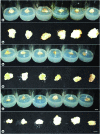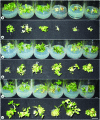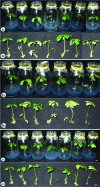Light-emitting diodes and their potential in callus growth, plantlet development and saponin accumulation during somatic embryogenesis of Panax vietnamensis Ha et Grushv
- PMID: 26019644
- PMCID: PMC4433904
- DOI: 10.1080/13102818.2014.1000210
Light-emitting diodes and their potential in callus growth, plantlet development and saponin accumulation during somatic embryogenesis of Panax vietnamensis Ha et Grushv
Abstract
In recent years, LED (light-emitting diode) has been the subject of research within the field of plant growth and development. However, there has been little discussion about using LED in vitro cultures of Panax vietnamensis, one of the important medicinal plants belonging to the Panax genus. This study examines the influence of various LED lamps on callus growth and plant formation of P. vietnamensis. Results show significant differences in growth and development, as various light conditions were suitable for different stages. Callus of 70 mg in fresh weight cultured under yellow LEDs resulted in growth of 1197 mg in fresh weight and 91.7 mg of dry weight, within a period of three months. The most effective plant formation was obtained when embryogenic calli were cultured under the combination of 60% red LED and 40% blue LED with an average of 11.21 plantlets per explant; the shoot clump fresh weight and dry weight were of 1147 and 127 mg, respectively, and the average plant height was 3.1 cm. It was also shown that this light condition was the most efficient for P. vietnamensis in vitro plant growth and development. This study provided additional evidence regarding the influence of different LEDs on ginsenoside production applying high-performance liquid chromatography (HPLC) analysis with photo-diode array (PDA) detection at ultraviolet (UV) wavelength 203 nm. The highest MR2 content was recorded when plants maintained under 20% red LED combined with 80% blue LED. However, the highest Rg1 and Rb1 content was found under fluorescent light. The results presented might provide new strategies using LEDs for adequate micropropagation protocols of P. vietnamensis.
Keywords: LEDs; Panax vietnamensis Ha et Grushv.; callus; spectrum.
Figures





References
-
- Luan TC. Results of studies on chemical composition of Panax vietnamensis. Workshop on preservation and development Ngoc Linh ginseng at Quang Nam province. 2003:62–75.
-
- Nhut DT. Huy BN. Phong PT. Hai NT. Luan TC. Primary study on multiplication of adventitious root of Panax vietnamensis – a valuable material source of saponin isolation. Biotech Agro Plant. 2006:118–121.
-
- Bula RJ. Morrow RC. Tibbitts TW. Ignatius RW. Martin TS. Barta D. Light-emitting diodes as a radiation source of plants. Hortic Sci. 1991;(26):203. - PubMed
-
- Schenk RU. Hildebrandt AC. Medium and techniques for induction and growth of monocotyledonous and dicotyledonous plant cell cultures. Can J Bot. 1972;50:199–204.
-
- Cuong HV. Nam NB. Luan TC. Vinh BT. Nhut DT. Effect of LED-light on growth and saponin accumulation of callus and plantlets of Panax vietnamensis Ha et Grushv. in vitro . J Sci Tech Vietnam. 2012;50(4):475–491.
LinkOut - more resources
Full Text Sources
Other Literature Sources
Miscellaneous
